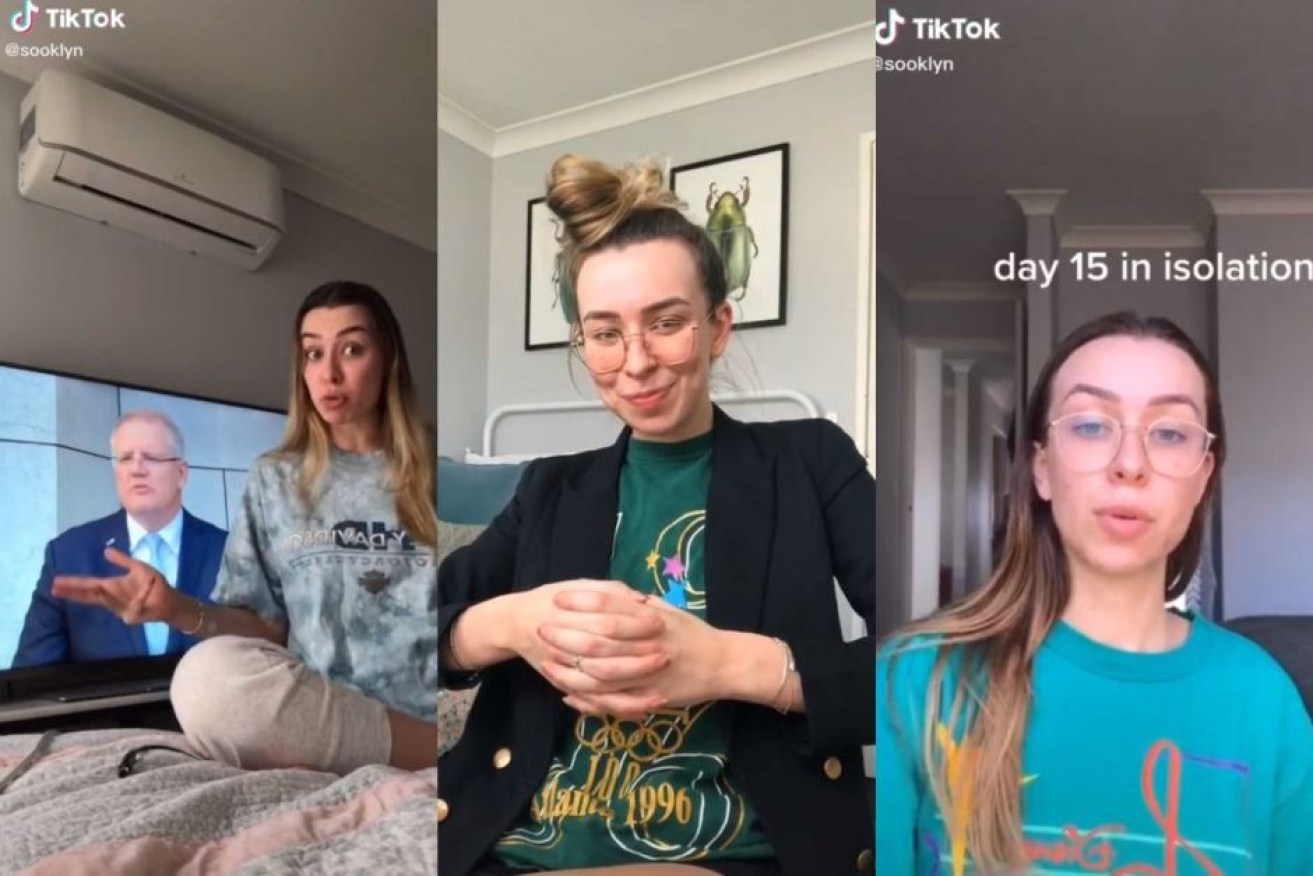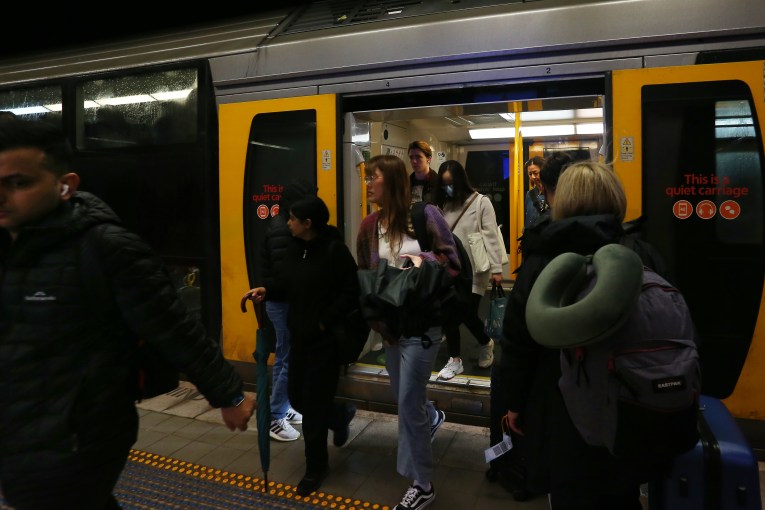TikTok offers connection, comedy and creativity during coronavirus lockdown

Brooke Taylor's (@sooklyn) TikToks have gone viral. Photo: Supplied/@Sookyln
“If it wasn’t for coronavirus, I wouldn’t have downloaded it — and the fact that I have makes me feel a little bit embarrassed,” says Hannah Baker, a new TikTok devotee.
The 27-year-old judge’s associate says one thing that got her hooked was the “pandemic content” on the social video sharing app.
TikTok has huge numbers of videos with coronavirus-related hashtags like #quarantine (25 billion views), #happyathome (11.5 billion views) and #safehands (4.1 billion views).
“Especially at the beginning, when the pandemic was scary, it was really nice to just be in this world of funny coronavirus-related videos, it made it all a little bit palatable and a little bit funny,” Ms Baker says.

Many are finding little moments of joy on TikTok. Photo: Supplied/Hannah Baker
Ms Baker isn’t the only one staying home during COVID-19 lockdown and switching onto TikTok.
TikTok doesn’t release download numbers but there are reports the app has seen significant jumps in downloads in the US and elsewhere, and the user base has clearly expanded beyond its original teenage audience.
“I’m just embracing it because it’s really fun and more and more people my age are getting into it,” Ms Baker says.
As with other social media apps, TikTok — which is owned by Chinese company ByteDance — has its issues and detractors, whether that’s allegations that the app censors anti-Chinese content or concerns about who might be accessing the app’s data and what teenagers and young people are posting (in response to this particular criticism, TikTok have recently introduced a Family Pairing function that will give parents more control over their children’s TikTok usage).
But for creators and new adherents, TikTok is offering a much-needed avenue for connection, creativity and comedy during coronavirus.
Fun for you and everyone you’re stuck in a house with
“I realised once I downloaded the app that there was so much amazing content on there, all these really quick, engaging videos — and the scrolling is so addictive,” says Ms Baker.
“Hopefully when the pandemic is over, I won’t be so addicted — but I’m just so in it right now.”
Driving that addiction is an algorithm that quickly learns your tastes and begins tailoring a “for you” video feed.
Ms Baker immediately turned her hand to making her own TikToks, learning viral dances and posting them to her small, yet dedicated, audience of friends and family.

Friends and families isolating together are turning to TikTok. Photo: Supplied/@hanzbakes, @aalisonfu, @frejaprice
“My housemates — who I’m in lockdown with — thought it was pathetic that I joined TikTok and started making videos,” Ms Baker admits.
“But the dances on there are just a few moves that you can easily learn and practise. It’s easy and efficient and fun.”
Her housemates soon agreed to make a video together — like many families stuck in lockdown — and now they’ve all been converted to TikTok.
‘It’s giving people a voice’
22-year-old Canadian Boman Martinez-Reid (@bomanizer) started making TikToks in December, making use of the editing and acting skills that he’d developed while studying radio and TV production.
When your step sister is eating your chips except it’s Reality TV pic.twitter.com/pFz8ZIwdoH
— Bojito (@Bomanizer) April 14, 2020
Mr Martinez-Reid has been isolating with his family in Toronto for over a month, and he says that at first, he struggled to find inspiration to continue making TikToks.
“But then I started looking at it differently and I realised that everybody is in the same situation: unable to leave their house, stuck with their loved ones, experiencing minor inconveniences that can easily blow up — which is my whole brand.”
Mr Martinez-Reid had already made a few reality TV parody TikToks that had reached a large audience, but his recent videos that depict small events that occur in social isolation (whether that’s stolen snacks or offhand comments) in the style of reality TV (think the Real Housewives franchise) have been hugely popular.
He says the growth in his audience since the pandemic started has “been insane” — with his follower numbers increasing from 150,000 before lockdown to 878,000 and counting.
Mr Martinez-Reid jokes that “people have nothing else to do other than watching my videos” — but there’s more to it.
“All day, I get messages about how I’m making people laugh and smile, and one girl messaged me to say her father has passed away from COVID-19 and my videos were getting her through it,” he says.

Martinez-Reid says it takes 2.5 hours to shoot these 60-second videos on his phone and then editing can take up to eight hours. Photo: Supplied/@Bomanizer
TikTok has already birthed a suite of full-time stars (including Australian teenager Rory Eliza, who quit school to become a TikTok influencer), and Mr Martinez-Reid is now fielding calls from agents and TV shows.
Mr Martinez-Reid compares TikTok to the early days of YouTube, when YouTubers — like comedian, filmmaker and musician Bo Burnham — were able to gain huge followings without already-established fame outside the platform.
“Now YouTube is driven by celebrity culture and content houses that create very expensive videos,” he says.
“People are interested in TikTok because it’s a platform for everybody, it’s a reversion to the original idea that the internet belongs to the people, and it’s giving people a voice.”
A creative outlet
Lip-syncing is one of the platform’s main content areas, and after Brooke Taylor’s (@sooklyn) imitation of the Prime Minister’s terse press conference interaction with ABC political editor Andrew Probyn went viral (with 1.5 million views), Triple J’s Sally and Erica then remixed that press conference interaction over Duke Dumont’s Red Light Green Light to further TikTok success.
That was natural fodder for Melburnian Jeff van de Zandt (@jzandt) who posted a TikTok — that’s since gone viral on TikTok and elsewhere online — of him dancing and lip-syncing to the Triple J remix.
Mr Van de Zandt is an art director who’s worked on recent musical theatre productions of Priscilla Queen of the Desert and Disney’s Aladdin.
“But then the pandemic started and the company that I run lost pretty much all of our clients overnight, so I had a lot of time on my hands,” he says.
“So I started filming a TikTok a day to keep my sanity — and also because I needed an outlet to keep creating.”
He’s seen a marked increase in followers on the platform since the pandemic started, growing from a handful of people to 45,000.
Hahah. This is AH-MAZING ! #COVID19AUS pic.twitter.com/EFFL6h2gCS
— What’s the Frequency, Kenneth? (@dameyon) March 30, 2020
“Now my feed is full of people my age, whereas before [the pandemic] it was a lot of young kids,” Mr Van de Zandt says.
“I do feel like some of the older people [on TikTok] are more intelligent about creating different and funnier content, though there are obviously young people making good content,” he says.
His Scott Morrison press conference lip-sync dance has nearly 890,000 views on the app (and 45,000 likes) and other popular TikToks of his include a lip-sync and dance to a musical mash-up of quotes from Netflix’s Tiger King and a lip-sync of Get Krack!n’s Kate McLennan and Kate McCartney’s lockdown restrictions explanation.

Van De Zandt, a long-time lip-syncer, joined TikTok when he heard that the app was where “lip-sync was having a new life”. Photo: Supplied/@jzandt
Mr Van De Zandt says the most common message he’s getting from followers is: “You are getting me through isolation.”
“There is so much doom and gloom, and you can’t leave your house, lots of negativity in the world — but TikTok is a place of silliness, for me,” he says.
He says there’s something for everyone on the app, whether that’s art, music, recipes or make-up tutorials.
“It’s a breath of fresh air from all the stress of what’s going on outside.”








